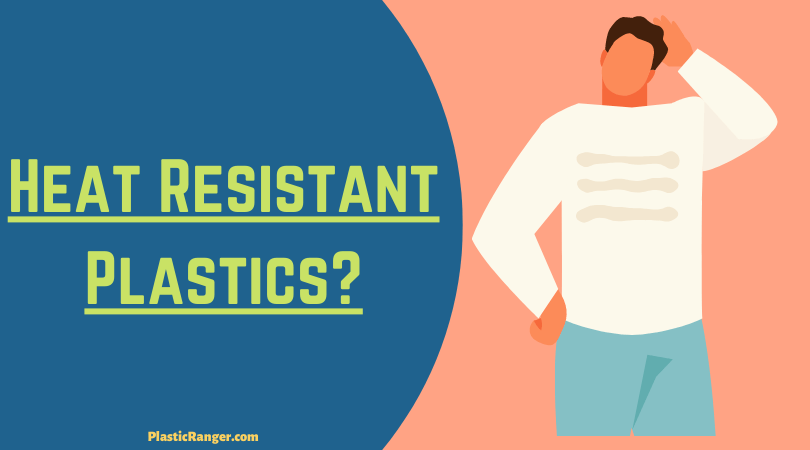Hello people. Today I will talk about the best heat-resistant plastic, useful in various applications. So without further ado, let’s get started.
Top 5 Heat Resistant Plastic Materials
Some widely-used heat-resistant plastics include PEI, PEEK, PTFE, PAI, and PPS. These materials are all thermoplastics, which means they can melt or soften when exposed to heat but will re-harden and regain their properties once cooled, as long as they are not heated to the point of combustion.
Manufacturers often lean towards metals like nickel and iron because of their excellent heat-resistant capabilities, making them ideal for high-performance applications.
However, many manufacturers opt for plastics that can replace metals and bring extra advantages.
For high-temperature applications, you need plastics to withstand thermal degradation while maintaining sufficient strength and stiffness at operating temperature.
Heat resistant plastics are a polymer material that can withstand high temperatures without degrading or losing their physical properties.
These materials are often used in applications where the plastic will be exposed to high temperatures, such as in automotive and aerospace parts and industrial and electrical components.
That is where heat-resistant plastics will come in handy. I’m talking about plastic material surpassing 150 °C in continuous operating temperature without trading off on mechanical properties.
Choosing the right high temperature plastics for your desired application is not easy; many things should be considered before making any major decision.
Today, the five plastics I will talk about aren’t just high-temperature plastic materials but are equipped with excellent attributes such as chemical resistance, corrosion resistance, and outstanding electrical and thermal insulating properties.
The is the list of the top 5 heat resistant plastics:
- PTFE (Polytetrafluoroethylene)
- PEEK (Polyether ether ketone)
- PEI (Polyetherimide)
- PAI (Polyamide-imide)
- PBI (Polybenzimidazole)
PTFE (Polytetrafluoroethylene)
PTFE or Polytetrafluoroethylene, known as Teflon, is a high-performance, versatile fluoropolymer made from carbon and fluorine atoms. It is known for its non-stick properties as it has the lowest coefficient of friction against any solid known to humanity.
It is also heat resistant, has outstanding chemical properties, low friction, high flexural strength, and good insulating properties in hot and wet environments.
The uniqueness of PTFE is sated by the fact that it is almost chemically inert and is practically insoluble in most solvents, making it perfect for high-temprature applications.
It also boasts one of the highest melting points in all the thermoplastics of 327 °C and a wide range of operating temperatures.
In addition, its excellent thermal stability makes it stable enough to be used anywhere between -200°C and +250°C.
| Property | Unit |
| Melting Temperature (°C) | 320 to 340 |
| Elongation at Break (%) | 300-550 |
| Tensile Modulus (MPa) | 550 |
| Surface Energy (Dynes/g) | 18 |
| Dynamic Coefficient of Friction | 0.04 |
| Dielectric Constant | 2 |
| Refractive Index | 1.35 |
| Dielectric strength (kV/mm) | 19.7 |
| Appl. Temperature (°C) | 260 |
Thanks to PTFE’s non-sticking and self-lubricating properties, it is a well-known non-stick cookware application.
Apart from that, it has a good presence in the engineering, automotive, and medical industries.
The most common PTFE applications in those industries are seats, plugs, fittings, pumps, diaphragms, impellers, Coatings for heat exchangers, valve stem seals, shaft seals, gaskets, O-rings, linings for fuel hoses, etc.
PTFE operates well at high and low temperatures, but its mechanical properties are inferior to comparable plastics at room temperature.
It has low radiation resistance, sensitivity to creep and abrasion, weak corrosion resistance, and is prone to toxic fumes.
PEEK (Polyether ether ketone)
PEEK, aka Polyether ether ketone, is a semi-crystalline, high-performance engineering thermoplastic material offering excellent heat resistance up to 260°C (480°F), a combination of excellent mechanical properties and resistance to chemicals, fatigue, creep, and wear.
The rigid, opaque, grey polymer belongs to the polyketone family of polymers (PEK, PEEK, PEEKK, PEKK, PEKEKK).
Amongst them, PEEK is the most utilized and widely manufactured on a large scale.
The polymer is so strong and adaptable to severe environments that it is often used as an alternative to metals in several applications, regardless of the temperature.
PEEK can resist temperatures up to 310°C for short periods and has a melting point of 370°C.
PEEK exhibits exceptional tensile strength, excellent creep resistance, good flexural modulus, high volume and surface resistivity, superior fatigue performance, outstanding steam or high-pressure resistance, low friction, good dimensional stability, inherent purity, and biocompatibility.
A few drawbacks of PEEK include being easily attacked by sulphuric, nitric, and chloric acids, halogens, sodium, and low resistance to UV lights.
It is also costly and thus can only be used in highly demanding applications.
PEEK can be processed best in Injection molding, Extrusion, and 3D printing.
However, the most significant applications of PEEK are found in industries like aerospace, electronics, and healthcare.
PEI (Polyetherimide)
Polyetherimide has been specifically developed to overcome the challenges faced by polyamides.
Although its branded name, ULTEM, also knows it, it is one of the few commercially available amorphous thermoplastics today.
Polyetherimide is, in a way, an improved version of polyamides and exhibits high-temperature resistance and excellent mechanical and electrical properties.
It is also strong, flame-resistant, and boasts the highest dielectric strength among all the thermoplastics.
PEI has a high melting point of 220°C and a maximum continuous service temperature of 170°C.
High melting point and heat resistance capabilities make it an ideal choice for aerospace parts.
Polyetherimide possesses high tensile strength, flexural modulus, and the ability to retain mechanical properties at elevated temperatures.
It also exhibits one of the best creep resistance amongst mainstream and high-performance thermoplastics and holds well against fuels and coolants.
Some drawbacks of PEI include low colorability, high production costs, and low resistance from polar chlorinated solvents, acetates, and aromatic hydrocarbons, leading to stress cracking.
PAI (Polyamide-imide)
PAI is another high-performance thermoplastic with high-temperature resistance, high thermal stability, good chemical resistance, and supreme wear properties with temperatures up to 275°C.
PAI also exhibits high tensile and compressive strength. Polyamide-imide can be processed in injection and compression molding techniques.
Polyamide-imide is mainly used in wire coatings to make magnet wires. Parts will be manufactured with PAI will also show high mechanical loading capabilities.
Apart from that, PAI material provides uplifted levels of toughness and rigidity.
PAI’s low thermal expansion and thermal stability contribute heavily to making dimensionally stable finished parts.
PBI (Polybenzimidazole)
PBI or Polybenzimidazole, also known as Celazole, boasts the highest heat and wear resistance, strength, and mechanical stability in all thermoplastics available today.
In addition, PBI fibers have no known melting point, don’t burn, and stick to other plastics.
PBI has an exceptionally high glass transition temperature of 427°C and offers outstanding load-carrying capabilities in extreme temperatures.
It has a continuous service temperature of 398°C in inert environments.
However, not everything is full of roses and sunshine; PBI is costly and extremely difficult to manufacture.
Machining this material can only be done with diamond tools, increasing costs.
From the design perspective, one more disadvantage of PBI is the notch sensitivity.
General Applications of Heat Resistant Plastics

Heat resistant plastics, also known high temperature plastics, are available in many forms and shapes. These plastics manufacture a wide range of products for several industries. Here are some examples –
- They are used for heat and shock withstanding components in the automotive and aerospace industries.
- They are utilized to make emission proof, heat withstanding, and highly insulating in the electrical and semiconductor industry.
- They are extensively used for sterilization and hydrolysis proof components for the medical equipment industry.
- They are utilized for making radiation-resistant and emission proof components for the nuclear energy industry.
- They are also utilized for making various components in the chemical industry.
Interesting Read – 7 Best UV Resistant Plastics For Outdoor Applications
FAQs

Below are the frequently asked questions on high temperature plastic materials. Let’s dig deep to know more.
Can PVC resist heat?
The PVC heat withstanding capability is far less than all the plastics mentioned above. It can be specified for applications at 54.4°C (130°F). Its pressure withstanding ability also decreases substantially at elevated temperatures.
How is plastic affected by heat?
Ans. If a plastic material is exposed to heat for a prolonged period, they are affected by thermal degradation. Prolonged exposure to heat will cause loss of strength and toughness, becoming more prone to cracking, breaking, and chipping.
Does melting plastics release toxins?
Very harmful toxins and fumes are released when plastic is burned, and research has shown that it significantly increases the chances of cancer, respiratory illnesses, and congenital disabilities.
Which type of plastic will liquefy when burned?
This type of attribute is seen in thermoplastics. They can be heated, cooled, and reheated without significantly reducing their properties. In addition, thermoplastics liquefy instead of burning, making them easy to process in injection molding and subsequently recycled.
Which solvent can dissolve plastic?
There are many types of plastic out there with many kinds of solvents. Different solvents attack different plastics. However, the most common solvent will dissolve or at least affect its surface.
Interesting Articles To Read
- Top 6 Chemical Resistant Plastics
- Top 10 High Impact Resistant Plastics
- 7 Types of Plastics | An Helpful Illustrated Guide
- What is ABS Plastic | The Definitive Guide
- What is Polystyrene? | The Definitive Guide
- What is HDPE Material? | HDPE Properties | Advantages of HDPE | Disadvantages of HDPE | The Future of HDPE
The Conclusion
That’s all I want to say about heat resistant plastic materials. Always remember to choose wisely and consult your material supplier to know what material fits you the best. Selection of the suitable material is an integral part of the production, without which the quality of your output can suffer.
I would appreciate your comment on your reviews and thoughts in the comment box.
Have a fantastic day.
Quick Navigation



Mr. Habib,
I find it very puzzling that you have completely neglected half of the plastics market- THERMOSETS!! Glass filled phenolic molding compounds can provide properties equal to or better than the thermoplastics you listed, often at a much lower cost. And, thermoset materials have decades of proven experience being used in electrical, automotive, decorative, and houseware applications to name a few. You have done a disservice to the entire thermoset plastic family of materials by your shortsighted listing of only thermoplastics.
I understand your point, Steven. However, my focus was only on listing thermoplastics, that’s the sole reason I didn’t include any thermosets. I’ll take your feedback into account and make another list specifically about thermosets.